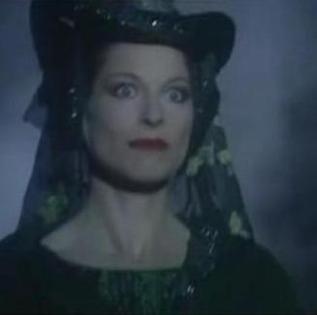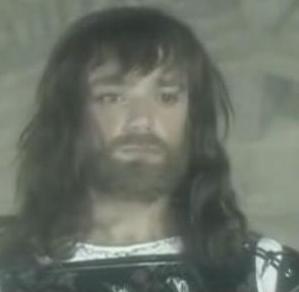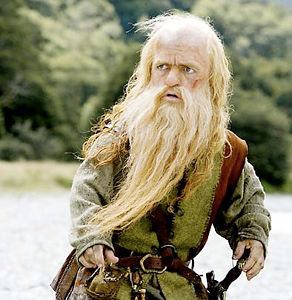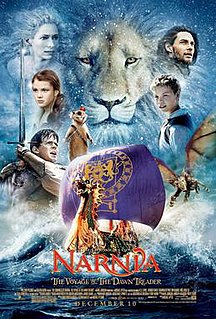The Voyage of the Dawn Treader
In The Voyage of the Dawn Treader , one of the first new characters to be introduced is Lord Drinian, the captain of the Dawn Treader . He is described as a dark-haired young man who loyally serves Caspian on his voyage to the end of the world. Although the seafaring trade in Narnia was severely limited by King Miraz's fear of the sea, Caspian, through his influence as the king, resurrects Narnia's interest in navigation and sailing. As a result, Drinian is one of a few Narnians with a vast knowledge of seafaring. Armed with these skills and his friendly sense of humor, Drinian greatly aids Caspian and his crew in their search for the seven lost lords.
Though Drinian is one of the most experienced sailors from Narnia, even he is occasionally surprised throughout the course of their journey. For example, when they reach the island that they later rename Dragon Island, they encounter a creature that most of the crew has never seen before: a dragon. Skeptical, Drinian asserts that dragons, like crocodiles, cannot be trusted and refuses to let his guard down. In fact, it is only upon discovering the dragon's identity (Eustace) that Drinian is able to trust it.
This cautiousness proves useful on another occasion. Later in their journey, Drinian spots something that turns out to be a sea serpent. Surviving the sea serpent's attack, Drinian and the ship head for a welcome respite in an approaching harbor. When Caspian suggests that they anchor in a different section of the harbor, Drinian obeys patiently but with a little reluctance at having his own choice for their resting place denied.
As they near the edge of the world, Lucy spots a fantastic view of merpeople who are unlike those she had seen in Narnia. Drinian realizes the possible danger they pose to his crew, as any of the men might fall in love with a mermaid or even in love with the world under the water itself and fall overboard; as a result, he orders Lucy to ignore the merpeople and act as if she had not seen them. When Reepicheep falls overboard, Drinian berates him out of worry because he fears for both Reepicheep's safety as well as the possibility that the crew may discover the merpeople.
After Reepicheep, Lucy, Eustace, and Edmund continue on their journey to the very edge of the world, Drinian successfully returns Caspian and the crew safely home to Narnia.
The Silver Chair
In The Silver Chair , Lord Drinian has remained a good friend and trusted advisor of King Caspian X. Though Caspian is depicted as being significantly older in this work than in the previous one, Drinian is not described in the same manner and appears to be very active for his age - Caspian is now 66 and in a state of health which suggests he is nearing the end of his life, yet Drinian is still riding a horse despite clearly being at least in his seventies. Drinian also became a close friend of Caspian's son Rilian.
After Caspian's wife is fatally bitten by a serpent, Rilian keeps returning to the woods where his mother was killed, clearly intent on tracking down and killing the serpent which killed his mother, but he never manages to find any trace of it. Drinian then approaches Rilian, however, and urges him not to continue trying to track down the serpent, only for Rilian to explain that he is not revisiting the scene of his mother's death for this reason. When Rilian leads Drinian to the very place where his mother died, Drinian discovers why Rilian is returning there. They spot a beautiful woman, who is clearly the reason for Rilian's decision to keep returning to this location. Although Drinian questions the attraction that Rilian has for this woman, he also refuses to question Rilian's motives any further and does not object to Rilian returning there in the future. Rilian then returns to the location but he never returns. Drinian helps in the search for Rilian but nobody ever finds a trace of him, leaving Caspian to fear that he will never see his son again. When Drinian presents his knowledge of the events leading to Rilian's disappearance to Caspian, he begs Caspian to condemn him as a traitor, for he has allowed the son of his good friend to disappear. Though Drinian implores Caspian for death as punishment for his treachery, Caspian is unable to kill him, not wanting to lose his friend as he has already lost his queen and his son, and the two mourn the loss of Rilian as friends. For the next 10 years, Rilian's disappearance remains an unsolved mystery, with nobody in Narnia knowing where he went to or whether he is still alive.
The serpent which killed the Queen was in fact the Lady of the Green Kirtle, who ruled the underworld beneath Narnia and was intent on breaking through to invade it. She later lured Rilian into the underworld. A decade later, Eustace Scrubb and Jill Pole entered Narnia and along with their guide, Puddleglum the marshwiggle, they found their way into the underworld to save Rilian, who then killed the Lady of the Green Kirtle, and returned to Narnia.
During the primary narrative of The Silver Chair, which takes place a decade after Rilian's disappearance, Drinian accompanies Caspian as he voyages through the seas explored in The Voyage of the Dawn Treader. Caspian had told his people that he wanted to make this voyage to see again the place of his youth, but many believed that he had gone to seek Aslan to ask who could be the next King of Narnia after his death, as he no longer expected to see Rilian again. But the voyage is disrupted by Aslan before they reach the end of the world, who explains to Caspian that he must return home to Narnia.
When Caspian is reunited with his lost son Rilian, an elderly Drinian is there to rejoice in the efforts of Eustace and Jill. He is also at Caspian's side when the king dies soon after, and witnesses the declaration of Rilian as King of Narnia.

The Chronicles of Narnia is a series of seven fantasy novels by British author C. S. Lewis. Illustrated by Pauline Baynes and originally published between 1950 and 1956, The Chronicles of Narnia has been adapted for radio, television, the stage, film and computer games. The series is set in the fictional realm of Narnia, a fantasy world of magic, mythical beasts and talking animals. It narrates the adventures of various children who play central roles in the unfolding history of the Narnian world. Except in The Horse and His Boy, the protagonists are all children from the real world who are magically transported to Narnia, where they are sometimes called upon by the lion Aslan to protect Narnia from evil. The books span the entire history of Narnia, from its creation in The Magician's Nephew to its eventual destruction in The Last Battle.

Narnia is a fantasy world created by C. S. Lewis as the primary location for his series of seven fantasy novels for children, The Chronicles of Narnia. The world is so called after the country of Narnia, in which much of the action of the Chronicles takes place.

The Voyage of the Dawn Treader is a high fantasy novel for children by C. S. Lewis, published by Geoffrey Bles in 1952. It was the third published of seven novels in The Chronicles of Narnia (1950–1956) and Lewis had finished writing it in 1950, before the first book was out. It is volume five in recent editions, which are sequenced according to the novels' internal chronology. Like the others, it was illustrated by Pauline Baynes and her work has been retained in many later editions. It is the only Narnia book that does not have a main villain.

The Silver Chair is a children's fantasy novel by C. S. Lewis, published by Geoffrey Bles in 1953. It was the fourth published of seven novels in The Chronicles of Narnia (1950–1956); it is volume six in recent editions, which are sequenced according to Narnian history. Like the others, it was illustrated by Pauline Baynes and her work has been retained in many later editions.

Edmund "Ed" Pevensie is a fictional character in C. S. Lewis's The Chronicles of Narnia series. He is a principal character in three of the seven books, and a lesser character in two others.

Eustace Clarence Scrubb is a fictional character in C. S. Lewis's Chronicles of Narnia. He appears in The Voyage of the Dawn Treader, The Silver Chair, and The Last Battle. In The Voyage of the Dawn Treader, he is accompanied by Edmund and Lucy Pevensie, his cousins. In The Silver Chair and The Last Battle, he is accompanied by Jill Pole, a classmate from his school.

Prince Caspian is a fictional character in The Chronicles of Narnia by C. S. Lewis. He is featured in three books in the series: Prince Caspian, The Voyage of the Dawn Treader, and The Silver Chair. He also appears at the end of The Last Battle.

The Lady of the Green Kirtle, also called Queen of Underland and Queen of the Deep Realm, is the main antagonist in The Silver Chair by C. S. Lewis. She is sometimes called briefly the Green Lady, and she is known also as the Emerald Witch; neither name, however, appears in Lewis's text. She enslaved Prince Rilian of Narnia and a horde of gnomes by her witchcraft, and planned to use them to take over Narnia. She is foiled by three friends of Aslan: Eustace Scrubb, Jill Pole, and Puddleglum, and is finally killed by Rilian.

In C. S. Lewis' Chronicles of Narnia fictional series, Rilian (2325-?) is the son of King Caspian and the grandson of Ramandu the star. Rilian appears in two of the seven books, The Silver Chair and briefly in The Last Battle.

The Chronicles of Narnia is a British BBC-produced television serial that was aired from 13 November 1988 to 23 December 1990 and is based on four books of C. S. Lewis's The Chronicles of Narnia series. The first series aired was The Lion, the Witch and the Wardrobe in 1988, the second series aired was Prince Caspian and The Voyage of the Dawn Treader in 1989 and the third series aired was The Silver Chair in 1990. This television serial was produced by Paul Stone, with the teleplay by Alan Seymour. The Lion, the Witch, and the Wardrobe was directed by Marilyn Fox, while Prince Caspian, The Voyage of the Dawn Treader and The Silver Chair were directed by Alex Kirby.
The Chronicles of Narnia series of films is based on The Chronicles of Narnia, a series of novels by C. S. Lewis. From the seven books, three were adapted—The Lion, the Witch and the Wardrobe (2005), Prince Caspian (2008), and The Voyage of the Dawn Treader (2010)—which collectively grossed over $1.5 billion worldwide.

Trumpkin is a fictional character in C. S. Lewis' fantasy novel series The Chronicles of Narnia. Trumpkin is an intensely practical and skeptical dwarf who lives during the reigns of King Miraz and King Caspian X. He is a major character in Prince Caspian, briefly mentioned in The Voyage of the Dawn Treader, and is a minor character in The Silver Chair.
Aslan's Country is a fictional location from C. S. Lewis' The Chronicles of Narnia series. It is the home of Aslan, the great lion. It is described as a series of mountains, thousands of feet high, but without snow or ice. Instead, Aslan's Country has a clear blue sky, lush green grass, colourful birds, and beautiful trees. There are entrances to Aslan's Country from all worlds, including Narnia and Earth. It is located beyond Narnia's rising sun at the eastern edge of the world, and indeed rings around the whole Narnian world.
The Seven Great Lords of Narnia are fictional characters in The Chronicles of Narnia by C. S. Lewis. They are briefly mentioned in Prince Caspian and are central to the plot in The Voyage of the Dawn Treader, the second and third published books, respectively, in the series.

The Chronicles of Narnia: The Voyage of the Dawn Treader is a 2010 fantasy-adventure film based on The Voyage of the Dawn Treader (1952), the third novel in C. S. Lewis's fantasy series The Chronicles of Narnia. It is the third and final installment in the original Chronicles of Narnia film series, and the only film in the series to be released in Digital 3D. It is also the only film in the series not to be distributed by Walt Disney Pictures, who is replaced by 20th Century Fox. However, Disney would eventually own the rights to all the films in the series following the Disney-Fox merger in 2019.
The Silver Chair was a series shown on BBC television in 1990. It was the third and final series of The Chronicles of Narnia that ran from 1988 to 1990.
Prince Caspian/The Voyage of the Dawn Treader is the second series of The Chronicles of Narnia that ran from 1988 to 1990. The series, which was shown on BBC television in 1989, is an adaptation of two of C. S. Lewis's The Chronicles of Narnia novels: Prince Caspian (1951) and The Voyage of the Dawn Treader (1952).
The following outline is provided as an overview of and topical guide to Narnia:
Reepicheep the Mouse is a fictional character in the children's fantasy series The Chronicles of Narnia by C. S. Lewis. He appears as a minor character in Prince Caspian and as a major character in The Voyage of the Dawn Treader, and also briefly at the end of The Last Battle. Reepicheep is a Talking Mouse, the leader of the Talking Mice of Narnia; he is irascible yet imperturbably courteous, utterly without fear, and motivated by a deep concern for honour.











